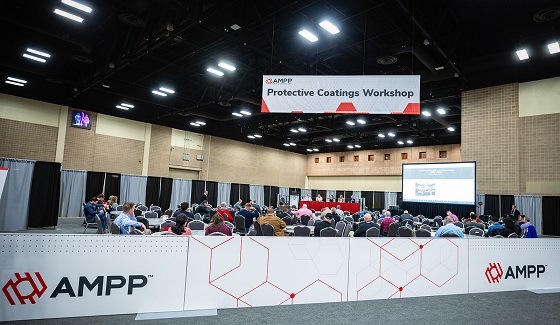Held this March in San Antonio, Texas, the 2022 AMPP Annual Conference + Expo included a protective coatings workshop. In that setting, Charles S. Brown, PCS — deputy director of coatings at engineering, design, planning, and construction management firm Greenman-Pedersen, Inc. (GPI) — gave passionate remarks on the importance of safety and personal protective equipment (PPE) when at a jobsite.
The U.S. Occupational Safety and Health Administration (OSHA) requires employees to protect their employees from workplace hazards through the use of engineering or work practice controls. When these controls are not feasible or do not provide sufficient protection, PPE is required.
Engineering Controls vs. PPE
Examples of engineering controls include isolation, ventilation, and equipment modifications such as tools with reduced vibration, noise reductions, or an attached dust collection system. Meanwhile, administrative controls can include procedures such as regular equipment inspection and maintenance, regulating select areas, and limiting exposure by time and/or distance.
PPE, which typically involves the worker wearing something such as a respirator, is used when other methods are not feasible or if they are not sufficient to fully protect against the hazard(s). While those other options can be effective, PPE is often the last resort at many jobsites, Brown explained.
Head and Face Protection
The type of PPE needed depends on the hazards to which a worker is exposed. If head protection is needed, Class G hard hats are satisfactory for general service use, while Class E is designed for electrical/utility work. Finally, Class C works if comfort and bumps against fixed objects are only at issue.
If protection is needed from flying particles or airborne particulates, safety glasses should meet the Z87.1 standard of the American National Standards Institute (ANSI). Other eye and/or facial PPE considerations may include goggles, welding shields, or face shields, according to Brown.
When working in a hazardous atmosphere, respiratory protection is typically needed, as well. To select an appropriate respirator, Brown pointed to OSHA guidance that calls for exposure assessment, jobsite and worker characteristics, and understanding the assigned protection factors and the various kinds of respirators, as well as their relevant properties.
For noisy jobsites, exposure to over 85 decibels can cause hearing loss, and hearing protection becomes required by OSHA at 90 decibels. Examples of hearing protection include ear muffs, noise-cancelling ear plugs, molded ear plugs, and disposable foam plugs. Each is required to include a Noise Reduction Rating on its package, which workers and employers can compare to the environment in question.

Body Protection
Another popular PPE choice on coatings jobsites is gloves, which are offered in forms such as anti-vibration, permeation-resistant, heat-resistant, cut-resistant, and leather palm. The nature and duration of expected contact, as well as the specific area(s) needing protection and requirements for grip, thermal protection, and abrasion/chemical/liquid resistance, are among the factors that may influence a worker’s glove selection.
Other PPE considerations may include body protection in the form of coveralls or other garments, as well as foot and leg protection with impact-resistant toe protection, heat-resistant soles, metal shanks, or even metatarsal guards. Specialty footwear can be liquid- or chemical-resistant, and conductive or nonconductive.
If accidents from limited visibility are a concern, highly visible/reflective vests can be essential.
Standards and Training
In all cases, employers are to provide at least some PPE in satisfactory condition at no cost to the employee. Employers also need to train employees on the use, care, and maintenance of PPE, as well as periodic reviews and updates to the company’s PPE program.
For their part, employees must actively participate in training, consistently use PPE as prescribed, and continually maintain and monitor PPE to be aware of its potential use (or limitations) in the future.
To that end, it can be important for asset and facility owners to work with qualified and accredited contractors and credentialed corrosion professionals, who are likely to be aware of the various needs, protocols, and processes.
For more information, contact: GPI, (631) 587-5060, www.gpinet.com.
Editor's note: Reprinted with permission
from the 2022 AMPP Show Daily.